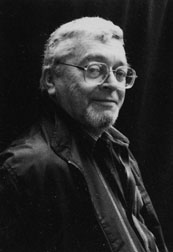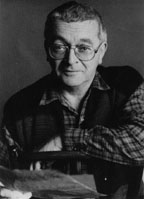
Mr. Hoban in the early 90s
Suddenly the idea of turning one's experience into a story seemed not only bizarre but perverted; the idea of such a thing as page one seemed at the very least a monstrous vanity. Where was the beginning of anything, how could I draw a line through endless cause and effect and say, 'Here is page one'?
--The Medusa Frequency (p.77)
 Mr. Hoban in the early 90s |
Last updated: January 31, 2003
Russell Hoban was born on February 4, 1925, at 2:50 a.m. in Philadelphia, Pennsylvania. His parents, Abram and Jennie Hoban, were Jewish immigrants from the Ukraine; his father was the advertising manager of a Jewish newspaper as well as the director of a Philadelphia drama guild. Mr. Hoban was thus exposed to the arts early on, and became interested in writing at an early age, winning prizes for his stories and poems during his school years. He has two sisters, Tana and Freeda, to whom The Moment Under The Moment is dedicated. (Tana took the sphinx photos on the jacket.)
Mr. Hoban served in the U.S. Infantry during WWII. For a time he taught art in New York and Connecticut. He then worked as a freelance illustrator, and eventually an advertising copywriter. He also managed to begin writing books during this period.
 Mr. Hoban in the 70s |
He began publishing children's books in 1958, and since then has published more than 50. Many of these books were illustrated by Lillian Hoban, whom he met at the Graphic Sketch Club in Philadelphia. They also studied together at the Philadelphia Museum School. They were married in 1944, and had four children: Phoebe, Abrom, Esmé, and Julia. Mr. Hoban mentions Esmé in the acknowledgements to Pilgermann, saying that in 1980 she and her husband Moti took him on the trip that inspired the book.
In 1968, he published his first full-length novel, The Mouse and His Child. It's widely regarded as a children's classic, though Mr. Hoban himself has said he thinks of it simply as his first novel, rather than a book strictly for children. It was made into an animated film in 1977, featuring the voices of Peter Ustinov and Chloris Leachman.
In 1969 Mr. Hoban moved to London (originally for a two-year stay) and has resided there ever since. His marriage to Lillian broke up about this time; she returned to the U.S. and continued to live in Wilton, Connecticut with the children. Though her collaborations with Mr. Hoban ended when the marriage broke up, she continued to write and illustrate children's books, including some collaborations with their daughter Julia (to whom Bread and Jam for Frances is dedicated).
Mr. Hoban published his first adult novel, The Lion of Boaz-Jachin and Jachin-Boaz, in 1973, and many more followed (see list on the home page). Riddley Walker, published in 1980, was his biggest publishing success, making the bestseller lists in the U.S. and garnering several awards, including the John W. Campbell Memorial Award in 1982, and the Australian Science Fiction Achievement Award in 1983. In 1985, his novel Turtle Diary was adapted into a film featuring Ben Kingsley and Glenda Jackson, screenplay by Harold Pinter.
In 1970, Mr. Hoban met Gundula, who became his wife in 1975. (Both The Lion of Boaz-Jachin and Jachin-Boaz and The Medusa Frequency are dedicated "To Gundel," the familiar form of her name.) He and Gundula have three sons: Jachin (Jake), to whom Kleinzeit is dedicated, Ben, to whom Turtle Diary is dedicated, and Wieland, the youngest according to a Trokeville Way acknowledgment, and to whom Riddley Walker is dedicated.
In recent years, Mr. Hoban's online following has developed into an international community of fans called The Kraken, who celebrate Mr. Hoban's birthday each year (February 4, nicknamed "Hoban Day") with a mysterious happening known as the SA4QE.
Mr. Hoban's most recent novels are Angelica's Grotto (1999), Amaryllis Night and Day (2001), and The Bat Tattoo (2002). His next novel, Her Name Was Lola, is due out in autumn 2003.
Back to The Head of Orpheus: a Russell Hoban Reference Page (home page).
Other Russell Hoban reference pages: